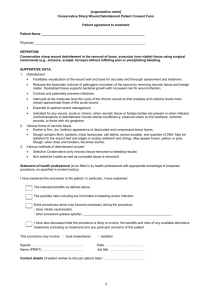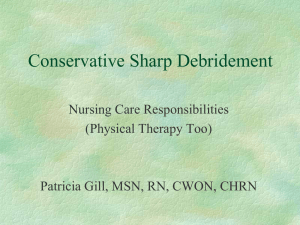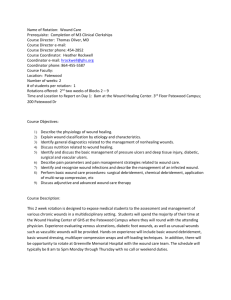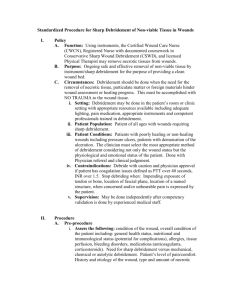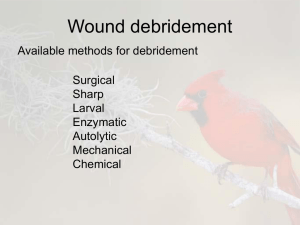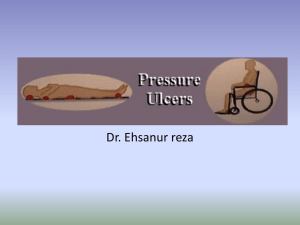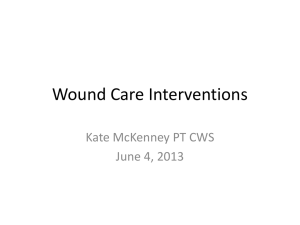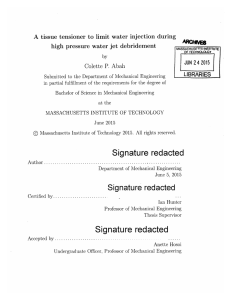Document
advertisement
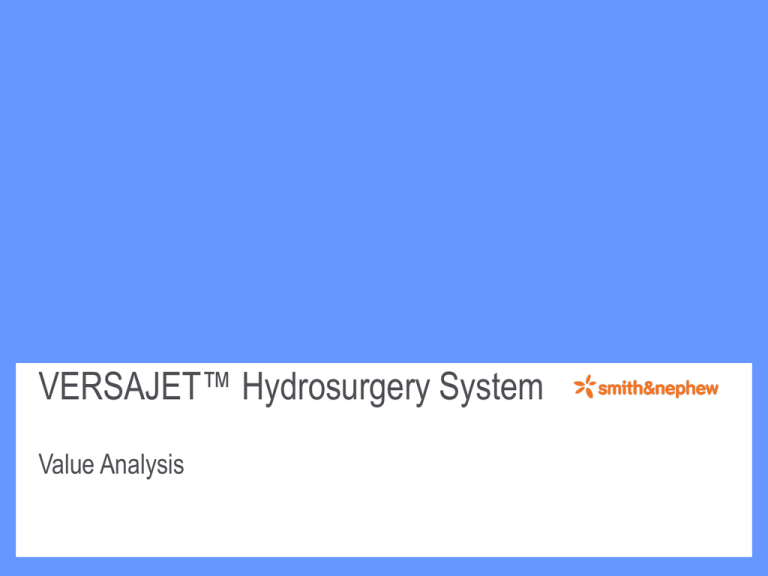
VERSAJET™ Hydrosurgery System Value Analysis VERSAJET™ • General Technology Overview • Features/Benefits • Summary of Evidence The VERSAJET◊ II Hydrosurgery System • A revolutionary wound excision technology from Smith & Nephew Wound Management. • Uses Hydrosurgery technology (water cutting) similar to that used in the cutting of materials during mining and manufacturing. • Consists of a powered console and single use disposable hand pieces. • FDA cleared and launched in the United States in 2002. VERSAJET™ II benefits VERSAJET™ Hydrosurgery System Venturi Effect The design of the VERSAJET is such that the high velocity fluid jet passes across the operating window and into the evacuation collector creating a localized vacuum to hold and excise targeted tissue while aspirating debris from the site. Tissue Excision Additional design attributes allow the user to finely control excision. Orienting the operating window parallel to the tissue optimizes the VERSAJET’s performance for tissue excision aspiration. Contaminant Evacuation Alternatively, orienting the operating window obliquely to the tissue optimizes the VERSAJET’s performance for contaminant removal – irrigation and vacuuming. The VERSAJET™ II Hydrosurgery System The VERSAJET II system enables a surgeon to precisely select, excise and evacuate nonviable tissue, bacteria and contaminants from wounds, burns and soft tissue injuries using a tissue-sparing technique1-2,4-5 Advanced hydrosurgery technology helps reduce time to closure, which may reduce overall treatment cost.1,2,3 Precision to preserve Principles of Hydrosurgical Debridement • Complete removal of undesirable tissue • Maximum preservation of collateral tissue • Wound closure Courtesy of Dr. Jeff Nelson Courtesy of Dr. Jeff Nelson The Clinical Benefits of Debridement • Removes necrotic tissue that impairs wound healing • Creates bacterial balance in the wound • Results in controlled bleeding that stimulates the production of bloodborne growth factors • Removes the senescent fibroblasts – leaving younger, more viable cells • Removes the hyperproliferative, non-migratory wound edge that slows healing Thorough debridement is paramount for the wound repair process. Classic Methods of Debridement • Radical excision is required for complex wounds • Scalpels are non-selective • Limitation exist for pulse lavage • Other invasive modalities cause collateral injury Courtesy of Dr. Mark Granick • CLEAN, FAST, and PRECISE • Tangentially removes tissue • Operation is clearly visible • No thermal effects • Time and cost savings • Improves patient outcomes Surgical Debridement Literature • Improves host defense mechanisms and reduces active infection (Elek 1956) • May enhance chronic wound healing (Steed et al 1996) • Reduces dysfunctional cell populations (Hasan et al 1997, Vande Berg et al 1998) • Promotes release of tissue cytokines and growth factors (Enoch & Harding 2003) VERSAJET™ Features and Benefits Features Precision Safety Benefits Economic Impact • Completely removes non-viable • Fewer surgical procedures required to tissue and particulate close the wound contaminants • Allows maximal preservation of • Less complex procedure required to viable tissue close the wound allowing for closure during the same encounter • ~40% to 60% faster procedural • Shorter healing time and reduced time than conventional length of stay techniques • Faster operating room turnover • Alleviates sharps injuries • Minimizes need for pulse lavage devices – less risk of splash back exposure and cross contamination • Reduced blood loss • Reduced costs of sharps injuries and contamination • Reduced risks to medical and nursing staff • Reduced risks to patients VERSAJET™ Summary of Evidence Clinical Study Granick, 2006 – Wound Repair and Regeneration; 14:394-396 Wound Type Chronic and Acute wounds VERSAJET™ [n=45] vs conventional debridement [n=22] In the O.R. Mosti, 2006 – Wounds; 18(8): 227-237 VERSAJET™ debridement [n=142] vs conventional debridemen [moist wound dressings, n=327] at bedside Outcome Fewer excision procedures required to close the wound [mean=1.2 Versajet –vs- 1.9 conventional] Net saving of $1900 per patient Chronic (hard to heal) leg ulcers 76% of patients achieved complete debridement with a single procedure. Pain was well tolerated with local anesthetic Shorter time to clean wound bed (1.3 days –vs- 4.3 days) Reduced hospital length of stay VERSAJET™ Summary of Evidence Clinical Study Dalla Paola, 2005 (poster at Turin) Wound Type Diabetic patients with amputation stub dehiscence. VERSAJET™ group had fewer subsequent amputations [2 vs 4], quicker healing [46 days vs 58 days] and fewer surgical procedures [2 vs. 3.5] Burn wounds. Removal of eschar to eyelids, fingers, web spaces More effective excision in difficult areas [cf Goulian and Watson knives] No patient required re-excision. No graft loss. Leg and foot ulcers Shorter procedure time in the O.R (39% quicker) Saving on pulse lavage (not required with VERSAJET™) Saving on instrument sets required ($500 instead of $21,000 VERSAJET™ [N=12] vs historical controls with conventional excision in the O.R Klein, 2005- J Burn Care Rehabil; 32(1): 64-69 VERSAJET™ excision of burn wounds [n=44]. Non-comparative Caputo, 2008 – Int wound J 5(2): 288-294 Randomized trial of VERSAJET™ vs conventional debridement in the O.R [n=41] Outcome Other Hospitals Using VERSAJET™ • Cleveland Clinic Foundation – Cleveland, Ohio • Washington Hospital Center – Washington, DC • The Ohio State University Medical Center – Columbus, Ohio • University of Medicine and Dentistry in New Jersey • Akron Children’s – Akron, Ohio • Mercer Medical Center Hospital – New Jersey • University of California – San Francisco (UCSF) • Clara Maass Medical Center – New Jersey • University of California, San Diego (UCSD) • Methodist Hospital – Minnesota • Wishard Memorial Hospital – Indiana • Johns Hopkins – Maryland • West Pennsylvania Hospital – Pennsylvania • Mayo Clinic – Minnesota • Duke University Health System – North Carolina • University of Illinois Medical Center – Illinois • Lehigh Valley Hospital - Pennsylvania • Long Island Jewish Medical Center – New Hyde Park, New York • Stony Brook University Hospital – Stony Brook, New York VERSAJET™ Financial Impact Debridement for certain patients (e.g. Medicare) is typically not profitable for hospitals • This is because patients typically require multiple operative procedures VERSAJET™ has the potential to: • Free-up operating room time, which frees resource to treat more profitable cases • In the Granick study the saving was equivalent to 45 minutes per patient • Reduce resource costs per patient and offset the cost of the handpiece in the Granick study: • Net saving $1900 per patient, including $127 reduction in materials spend • 1.9 and 1.2 debridements per patient mean the following: • The group of 10 patients may require 19 or 12 debridement procedures on average for traditional debridement approach and VERSAJET™ respectively • The first debridement is unavoidable; however, VERSAJET™ decreases the number of “second” debridement procedures • Thus, VERSAJET™ saves 7 out of 9 “second” or “repeated” debridement procedures Economic Model Disclaimer • The amount of savings is based on a peer-reviewed article entitled, “Efficacy and cost-effectiveness of a high-powered parallel waterjet for wound debridement.” Granick MS, Posnett J, Jacoby M, Noruthun S, Ganchi PA, Datiashvili RO. Wound Repair Regen. 2006 Jul-Aug; 14(4): 394-7. The savings are estimated for hospital operating expenses. To the bes of our abilities, we estimate the budget impact using available public and proprietary data and disclose all pertinent assumptions. • The new technology (VERSAJET™) may trigger changes in coding (i.e. excisional debridement 86.22 → non-excisional debridement 86.28). This may result in a lower reimbursed amount from either public or commercial payers. • Under no circumstances should this presentation be used by a health care provider for coding, payment or verification purposes AND Smith & Nephew is not responsible for any overpayment for health care services that may result from the use of this presentation. The Corporate Reimbursement Disclaimer provided at the end of the presentation prevails. Corporate Reimbursement Disclaimer The information provided with this notice is general reimbursement information only. It is not legal advice, nor is it advice about how to code, complete or submit any particular claim for payment. Although we supply this information to the best of our current knowledge, it is always the provider’s responsibility to determine and submit appropriate codes, charges, modifiers, and bills for services rendered. The coding and reimbursement information is subject to change without notice. Payers or their local branches may have their own coding and reimbursement requirements and policies. Before filing any claims, providers should verify current requirements and policies with the payer. References 1. Granick MS, Posnett J, et al. Efficacy and cost-effectiveness of a high-powered parallel waterjet for wound debridement. Wound Rep Reg 2006a;14:394-397 2. Granick MS, Boykin, Gamelli R, et al. Toward a common language: surgical would bed preparation and debridement. Wound Rep Reg 2006; 14 S1-S10 3. Cubison TCS, Pape SA, Jeffery SLA. Dermal preservation using the VERSAJET hydrosurgery system for debridement of paediatric burns. Burns 2006;32:714-720 4. Duteille F. et al. Management of 2nd-degree facial burns using the VERSAJET hydrosurgery system and xenograft: A prospective evaluation of 20 cases. BURNS. 2012;38(5):724-9. 5. Matsumura H. et al. The estimation of Tissue Loss During Tangential Hydrosurgical Debridement. Annals of Plastic Surgery. 2012:69(5):521-525
